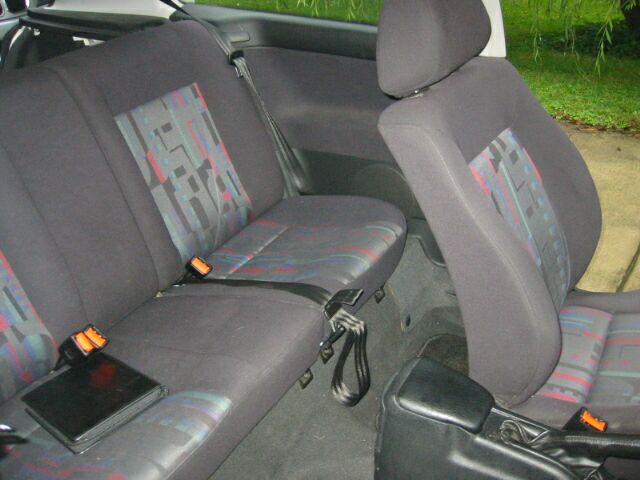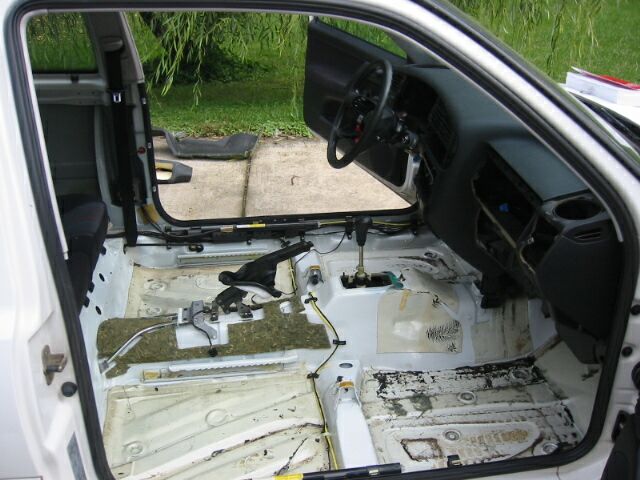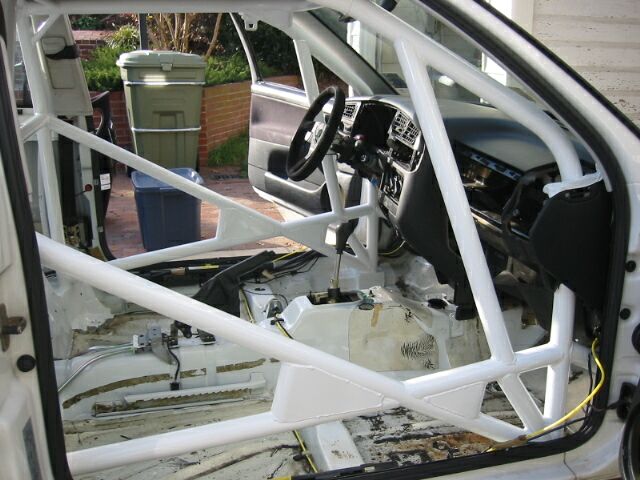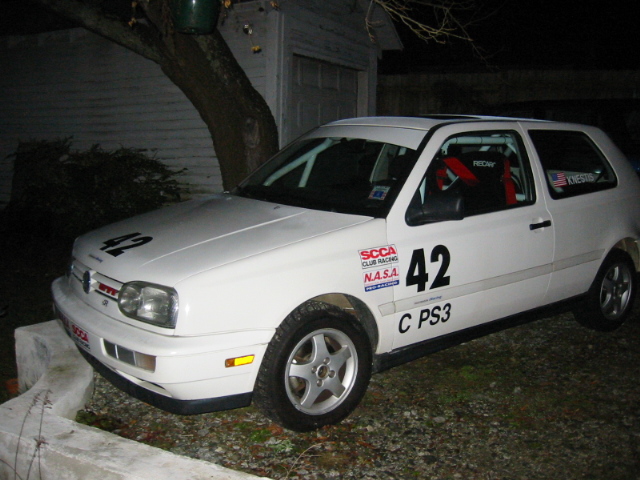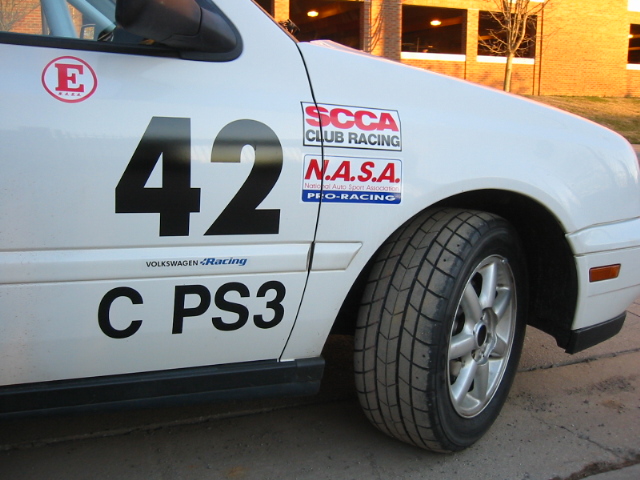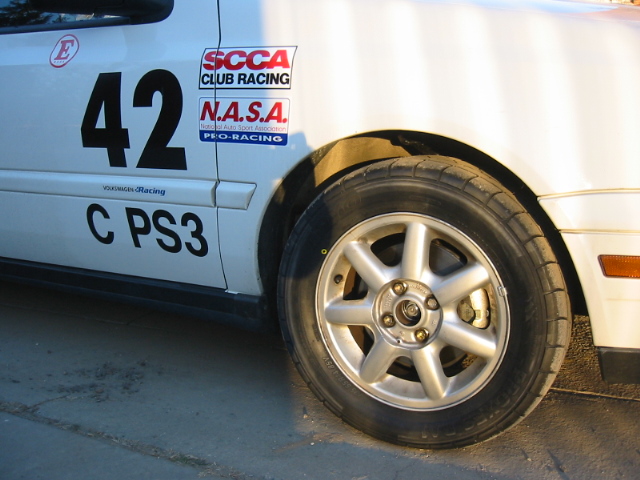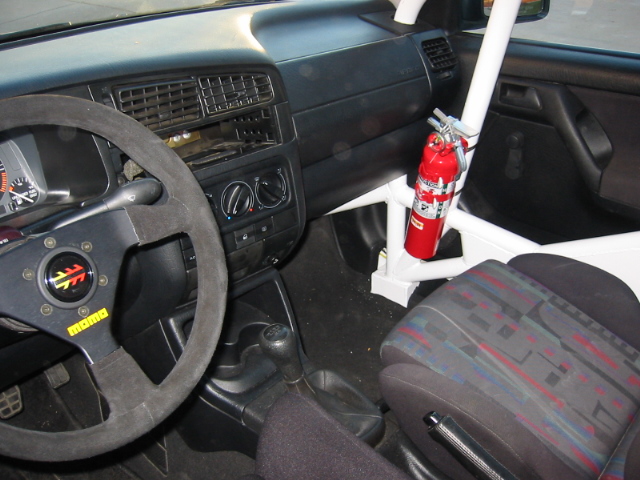Building
Project GTI
Showroom Stock C Class
Winter
2003
Given
the restrictive rules of the Sports Car Club of America's Showroom Stock
category, most of the mechanical changes to this high-mileage VW are made
in the name of safety.
To make the required modifications, it was first necessary to remove much
of the interior of the car. This was a little painful because the car
was so well cared for and the interior was in great shape.
|
|
The front seats,
carpet pieces, center console, rear interior panels except for the doors,
stereo system, and much of the dashboard were removed and tagged to
facilitate reassembly.
The dash was disconnected
from the car and the electronic components were removed but the bulk
of the dash structure was left sitting in place, to facilitate placement
of the rollcage tubes that would have to pass through it.
The rear seat was
unbolted but left in place. Since it is required that it be in the car
in Showroom Stock, it was necessary to design the cage to both clear
it and allow its removal for welding.
The 65 cents in
change found when the interior was stripped was put into the racing
budget. The gum in the otherwise clean ashtray was not.
|
|
A
full rollcage structure, carefully bent out of 1.75 x .095 seamless
steel tubing, was fitted and welded into the stock body shell by
Competition Cages of Hillsborough, NC. Careful attention was paid
to the joints, as tubes were "fish-mouthed" to ensure tight
joints for welding.
The
rollcage design is an adaptation of one used in Europe by the VW factory
Polo rally cars. More information on these cars can be found at www.vwmotorsports.com.
The
racing seat and steering wheel - installed to improve driver control
and safety - were test-fit during rollcage construction to optimize
the driver's seating location. The seat belt tab in the upper corner
of the door area is the quick-release mount for the window net mentioned
further down this page.
|

|
The cage design
incorporates corner gussets as required by rally rules - a feature made
necessary by the multipurpose nature of this racer.
The diagonal elements
in the cage increase the strength and stiffness of the structure, while
the horizontal bar behind the seat guides the driver's harness - the
seatbelt - to the proper height behind the seat.
To maximize safety,
the cage is designed to fit closely along the roof and pillars of the
body shell This posed a challenge for the fabricator as rules require
that the stock headliner be retained: Minor dirt and smoke damage did
nonetheless result but will be scrubbed out when the car is detailed.
|
|
The
cage also incorporates optional braces to the back side of the front
fenders, to maximize protection of the driver's feet.
All cage elements
are welded to plates or boxes, that are in turn welded to strong points
of the body shell after paint and sealer have been stripped from those
areas.
The massive triangulated
structures in the lower door opening area serve the dual purposes of
stiffening the chassis and providing intrusion protection in the case
of side impact. They actually touch the door speaker grill and interior
panel when the door is closed, to provide as much room as possible for
the driver.
|
|
The
rollcage was cleaned and painted - with a brush and rust-resistant paint
- to
prevent corrosion and make it easy
to keep things neat and tidy.
At this same point
in the construction process, fitment of the dashboard was checked and
final trimming was done. Electronic components - switches, gauges, and
wiring - were reinstalled once the dash was screwed back in its place.
|
|
The carpet was cut
around the rollcage mounting points and reinstalled, as were the interior
panels and door sill trim pieces.
It was necessary
to modify the side interior vents where the rollcage passes through
the dashboard, in the spaces previously occupied by speakers. Speaker
grills were cut and reinstalled as were the dashboard knee pads.
The stock airbags
are removed for racing but rigid foam padding is added to critical areas
of the rollcage and a window net is installed - to keep the driver's
arms in the car and other objects out, in the event of an on-track incident.
|
|
The aftermarket
racing seat features side bolsters to retain and protect the driver's
head, while the stock passenger seat and belts are reinstalled, as required
by Showroom Stock rules.
Visible in this
picture are the rolled sheet steel "taco" gussets incorporated
to strengthen the cage near the tops of the A-pillars. Similar gussets
are incorporated in the door bars of the cage to increase strength and
stiffness.
Note too that the
unusual vertical tubes in the door area provide a direct structural
resistance to any force downward at the top of the windshield, as might
be encountered should Project GTI have the misfortune to roll on the
race course.
|
|
The rear interior
panels and carpet were reinstalled, with the exception of the spare
tire cover and rear parcel shelf, which may be left out under Showroom
Stock rules. These parts - along with the stereo and optional fog lights
- were sold to offset a small part of the cost of construction.
The rear seat was
installed in a semi-folded position to accommodate the rollcage structure
but must remain in place as well. The rear seatbelts will never be used
again.
|
|
Required
graphics were completed in the evening on a day in January when it wasn't
below freezing in Greensboro, NC. Not the ideal conditions but it is
necessary to have numbers, class designations, and sanctioning body
stickers before a car is eligible to compete.
That this car is
intended to be used for more than one type of racing under a variety
of sanctions is reflected in the presence of both Sports
Car Club of America (SCCA) and National
Auto Sport Association (NASA) stickers on its flanks.
Competitiveness
between the organizations makes it necessary to tape over one set of
stickers while running in events put on by the other group but Project
GTI is all about "getting along" in a variety of racing settings
so it's a small price to pay.
|
|
Project GTI sits
on full-tread 205/55-14 DOT-approved Toyo racing tires from PhilsTireService.com,
that are substantially wider than the 195/60-14s that come stock on
the car in 1996.
Showroom Stock rules
limit tire width to an increase of not more than +20 beyond the original
size and aspect ratio to a decrease of not more than 10. The final decision
was made considering clearance (since the fenders cannot be modified
in any way), and outside diameter - since that influences the effective
final drive ratio of the required stock gears.
The tire manufacturer,
model, and tread depth were chosen to be a compromise toward lower cost
and better longevity. There are "faster" tires available but
not as economically.
|
|
Wheels are stock
14x6" VW "Orlando" alloys, one of just a couple of options
that satisfy the requirements of the SS rules.
Hiding behind the
wheels are new stock brake calipers and lines, struts, rotors, CV joints,
wheel bearings, balljoints, and hardware - all replacing the corroded,
118,000 mile pieces that came on the car.
Stock brake pads
may legally be replaced with aftermarket racing pads, like the Hawk
Blue compounds available from Cobalt
Friction.
The "E"
logo on the upper door shows race emergency personnel that the fire
extinguisher is located just inside the window, which must be open when
on the race track.
|
|
A
2-pound Halon 1211 fire extinguisher is mounted in a metal bracket within
reach of the driver. While the manufacture of new Halon is prohibited
under international environmental accords, recycled gas is still available
commercially. It is a superior extinguishing agent in many respects,
even if relative scarcity and complicated procedures have made it expensive.
The steering wheel
is a smaller-diameter, suede-covered unit. The smaller size facilitates
driver entry and exit from the car and, since the stock power steering
must be retained, there is no measurable increase in steering effort
as would be the case with a manual rack.
The hole in the
dashboard is evidence of the removal of the radio - one of the few pieces
that may legally be tossed out in Showroom Stock.
Cup holders will
not typically be used in racing conditions.
|
|
The
driver is held firmly in place by a set of 3-inch-wide, FIA- and SFI-rated,
6-point harnesses. The shoulder straps wrap around a rollcage member,
while the lap and double "anti-submarine" belts mount to the
floor immediately adjacent to the stock sliding seat brackets on the
floor.
This mounting hardware
utilizes high-strength eye-bolts, to which the harness ends clip, and
stainless nuts and washers on the bottom of the car, to prevent corrosion.
Red harnesses were
selected to improve visibility, for driver changes during endurance
races and driver safety, should anyone have to find and undo the harnesses
in a hurry someday.
The triangular box
structure at the base of the main rollcage hoop is just visible to the
left of the door jam. It ties into both the rocker panels and a main
transverse element in the stock body shell, on which the rear seats
are mounted.
|
|
The
final package is ready to go racing, even as it retains typical street
car driveabilty and license plates.
The suspension has
been aligned and all engine hoses, accessory belts, and what appears
to have been the original timing belt - yikes - have been replaced.
Coolant and fluids have been serviced, as have filters and a number
of electrical components.
Now, see Project
GTI in action or check in on the second evolution of the modification
process - upgrading Project GTI to Improved Touring
specifications.
|
|
| Breaking
News |
PhilsTireService.com Team GTI is a confirmed entry for the Charge
of the Headlight Brigade 13-hour endurance race, to be held at Virginia
International Raceway on October 23rd. This will be interesting from a
technical standpoint because the decision has been made to upgrade the
trusty Golf from Showroom Stock C to Improved Touring B specification,
with a variety of bolt-on performance parts - including high quality KONI
coilover racing struts, race-ready brake pads from Cobalt
Friction Technologies, original equipment and racing parts from Bildon
Motorsport, and wider-section, lower-profile Toyo Proxes RA-1 tires
from PhilsTireService.com.
That
pretty interior will be coming out again - this time to stay - and a variety
of other minor improvements will be made to bring the car to ITB standards
and prepare it for more than half a day of on-track excitement. The next
phase of the build will be documented here, so check back regularly.
If you
are interested, you are invited to follow the technical
story of the upgrade. |
| Last
updated 09 May 2004 |
Project
GTI is headquartered in Greensboro, NC
|

